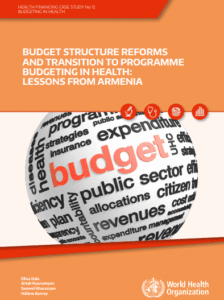 WHO’s case study of ongoing budget reform in Armenia finds that Armenia’s gradual transition to program-based budgeting has improved the National Assembly’s ability to assess the extent to which budgets are consistent with policy and track program performance through the introduction of indicators for quantity, quality and timeliness of health services. Armenia’s National Immunization Program is a consolidated activity within the Public Health Program, tracked by seven quantitative indicators, which has lent it visibility and may have contributed to a nearly 12-fold increase in immunization funding over the last decade.
WHO’s case study of ongoing budget reform in Armenia finds that Armenia’s gradual transition to program-based budgeting has improved the National Assembly’s ability to assess the extent to which budgets are consistent with policy and track program performance through the introduction of indicators for quantity, quality and timeliness of health services. Armenia’s National Immunization Program is a consolidated activity within the Public Health Program, tracked by seven quantitative indicators, which has lent it visibility and may have contributed to a nearly 12-fold increase in immunization funding over the last decade.
Armenia’s transition to program-based budgets is part of a larger series of reforms that began in the 1990s, which has included the development of a public Basic Benefits Package, primary health care reform, the introduction of output-based provider payments, civil service reform, and devolution of responsibility for health care providers to the regional and local levels. Armenia continues to build on these reforms to improve links between policy priorities and budget programs, strengthen the performance measurement framework, more fully transition budget appropriation from the activity to the program level, and strengthen the role of program managers.
